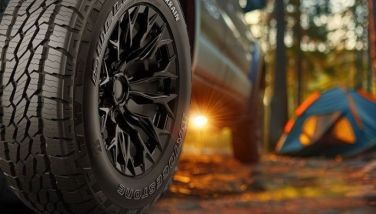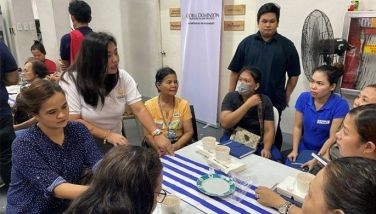Have a guitar
July 21, 2006 | 12:00am
 There are dudes who like cars, and there are dudes who like guitars.
The two groups may overlap, but dudes who primarily like guitars tend to be less concerned about cars – except as much as the car is spacious enough to carry their amps, guitar equipment and other gear.
There are dudes who like cars, and there are dudes who like guitars.
The two groups may overlap, but dudes who primarily like guitars tend to be less concerned about cars – except as much as the car is spacious enough to carry their amps, guitar equipment and other gear.
I’m not a guitar geek. But I do like my guitar, which is a red Fernandes. I would never name it, as B.B. King and Jimi Hendrix and countless other obsessed musicians have done in the past. I know my guitar is not my bestest friend ever; I just like picking it up once in a while.
I decided to talk to some local musicians to find out what they look for in a guitar. Seeking some common-sense tips on buying and caring for one’s axe, I posed the following questions to jazz guitarist Johnny Alegre (of Affinity), Francis Reyes (The Dawn), Diego Mapa (Monsterbot, Cambio), Marc Abaya (Kjwan, Sandwich) and, to get a female perspective, Kris Gorra-Dancel (Cambio, Fatal Posperos).
Their answers ran from the pithy eight-bar solo (Marc’s) to the epic extended jam session (Francis’s). If I missed out on countless other excellent guitarists in our midst, don’t worry; I’ll catch you next time.
It turns out all the respondents had at least one thing in common: every one of them mentioned Ari Hipolito, a legendary luthier with a shop near España, as the go-to guy for guitar patch-ups.
What do you look for when buying or playing an electric guitar?
JOHNNY ALEGRE: The most essential thing: it must stay in tune. When I go hunting for a guitar, I naturally gravitate to the best-looking candidate on the rack, and then proceed to tune it. If the instrument is un-tunable, it’s pretty much useless and so I will move on to next candidate. I start tuning with open strings, making sure they all resonate sympathetically with each other. Next, I tune the same set of strings on the 12th fret, pressing the strings hard on the fret and checking the octaves. Then I pluck the strings to produce the harmonic and compare if the pitch matches the octave. A good instrument will always ring with clarity and consonant tones. Also watch out for "dead spots," or muted frets, that will entail more fixing.
There are other considerations: fullness of tone and balance between strings. A well-crafted guitar sounds robust and full-bodied even in the high registers, and will vibrate clearly in the low frets.
FRANCIS REYES: Aesthetically, I’m drawn to classic designs and shapes, so no pointy metal guitars for me! I’m partial to set-neck guitars, which to my ears have better sustain overall. Even if it’s an electric guitar, I always check how it sounds acoustically, without an amp. I check the neck for back-bowing, warping and dead spots; every note on every fret on every string has to ring out properly. The "action" (height of the strings from the fretboard) has to be comfortable. Sometimes this isn’t so obvious when you plug it in with the distortion set to "incinerate." Distortion tricks you into thinking a guitar has nice action and great tone because the guitar just seems to react with little effort, but that’s the distortion doing the work, not your fingers. Bottom line is, if it’s playable naked and uncolored, if it sounds good unplugged, it will sound good plugged in. If not, you can always tweak or change the pickups.
DIEGO MAPA: Actually, first for me is the shape (heh-heh-heh), then the sound, as long as the tuning system works and the pickups are fine – as in the whole technical aspect from the knobs to the frets are working fine. Then I don’t mind the shape at all, even the brand. Many local guitars sound really good. Weight is also a factor: the lighter, the better.
KRIS GORRA-DANCEL: When I was in high school I didn’t care what kind of guitar I had as long as it was red. So I got me a red guitar with a Floyd Rose bridge, which was definitely not suited to the kind of music I played and gave me head (and finger) aches changing strings. So I learned it was important to pay attention to what guitar was suited to the kind of music I wanted to play.
Today, I favor my Gibson Explorer for live shows, and my Mexico Fender Stratocaster for recording. Both are versatile, great for rhythm and lead playing and come in different shades of red (tee-hee). Those on a tighter budget may opt for Fender Squire or Epiphone guitars. I also owned a semi-hollow, lipstick-pickup Danelectro that was pretty cheap and matched the personality of my band at the time, Fatal Posporos.
MARC ABAYA: The "feel" and sound of a classic Gibson or a Fender.
What kind of amps do you prefer using?
JOHNNY: I like Marshall and Fender amps, particularly those fitted with one or more vacuum ("valve") tubes in the pre-amp stage. They’re like a practical compromise between modern solid-state integrated circuitry, and the classic tube amplifiers from the ’60s and ’50s. I find the sounds they create very pleasing and warm.
FRANCIS: I like amps that are super clean and distortion-free even at really loud volumes. I’m not too fond of amps that "break up," because I need clean tones to begin with. I usually get my distortion from a pedal or a preamp; if the amp has a footswitch, I switch over to the overdrive channel and use that. I love how high-gain all-tube amps sound but after a few hours, those tend to sound compressed. They’re great for solos, but with chords, they eventually get mushy and I can’t get dynamics properly. My preferences are Fender Twins, and Mesa Triple Rectifiers.
DIEGO: When I walk in at a gig I prefer Peavey or Fender amps.
KRIS: I’ve observed that Gibson guitars sound great with Marshall tube amps while Fender guitars sound brightest with Fender Amps. However, Peavey makes the sturdiest units. Vox makes the sweetest sounding amps but I heard they break down easily. I have a 60-watt Laney at home – it sounds great and it’s reasonably priced to boot.
MARC: Amps that offer "warmth" and ‘"texture." Fender amps are cool, Mesa Boogie’s are even better!
To wah-wah or not to wah-wah? (What effects pedals rock?)
JOHNNY: I’ve been using only two pedals: a digital delay and an overdrive. I’m not very fond of fuzz or heavy metal distortion, simply because they don’t seem to push all the frequencies evenly. I like digital delays because they enable me to create intimacy by matching the guitar sound to the size of the room.
FRANCIS: If you’re a jazz guitarist, all you need is a good guitar, a good cable, and that’s it (and practice, of course). If you’re a rock or metal guitarist, definitely an overdrive or distortion pedal, and there are many variants around. Beyond that, I can gig with just a distortion and a delay pedal. Choruses, flangers, phasers, ring modulators, wahs and Whammy pedals are all fun and expressive but not really essential for me. You can pretty much play any genre with a simple distortion and delay setup. It’s all about turning knobs on the pedals, on your guitar, on the amp. Use your ears, and your fingers: your touch is primary, really. Having said that, I recently purchased a Zoom G7 multi-effects unit, which has all the things I mentioned above. But I always start with a clean, clear amp tone. Everything else is icing. If the guitar is a woman, effects are just makeup. And no amount of makeup can make a hideous woman (or man) look any better.
DIEGO: I use a SansAmp for my overdrive; my other favorite pedal is a Boss Delay 2.
KRIS: It all boils down to taste. I’ve tried both digital and analog effects. Analog still feels good to stomp on onstage but I usually record with digital effects. I normally bring a Boss Dual Overdrive, T-Wah, Equalizer, Delay and my most precious Pedal Tuner, which serves both as a power supply and tuner onstage.
I got a nice lecture from guitar god Nitoy of The Jerks. He said a good guitarist didn’t need pedals, didn’t even need an amp. The guy plugs in direct to the board and still sounds good! How the heck does he do that?
MARC: Boss FX pedals! EQ for "molding" your sound (it also acts as a noise gate to some extent) and the classic Metal Zone for gain.
Which guitarists have influenced your sound/tone/style, and why?
JOHNNY: I grew up in a house littered with old, hand-me-down vinyl records. I dug Scotty Moore’s rhythm guitar in the Sun-era Elvis Presley singles. The ’60s British Invasion and Blues Revival guitarists also captured my imagination: George Harrison, Eric Clapton, Jimi Hendrix, Jeff Beck, Jimmy Page. Later, I also enjoyed listening to B.B. King, Muddy Waters and Buddy Guy. Then I heard John McLaughlin with Miles Davis, and I realized jazz was the musical realm where I wanted to express myself. That led to Wes Montgomery, Joe Pass, Pat Martino, and modern players like Pat Metheny and Peter Bernstein.
FRANCIS: Hendrix is definitely at the top of my list. In terms of tone, I think a lot of kids these days think he sounds ratty but you have to listen to things in context: in the ’60s, he was definitely high-tech! He was firmly rooted in the blues and R&B but went on to redefine rock guitar. For jazzy guitar tones, my points of reference are Pat Metheny, Jim Hall and Wes Montgomery: their collective tone is jazz guitar. Montgomery is the benchmark for jazz guitarists, while Pat Metheny is definitely my favorite musician. His solos are quintessential jazz guitar, but his songs are from all over the place.
Robert Fripp and Adrian Belew of King Crimson are huge influences. The Edge of U2: How can you not be affected by his sounds and songs? Alex Liefson of Rush plays a lot of big open chords that are essential reference points if you are the only guitarist in your band.
(Francis goes on to list 100 others, including Eric Johnson, Steve Vai, Allan Holdsworth, Tom Morello, David Torn, John McLaughlin, Al DiMeola, Teppei Teranishi of Thrice, Justin Beck of Glassjaw, Ben Weinman and Brian Benoit of the Dillinger Escape Plan, David Gilmour of Pink Floyd, Adam Jones from Tool, Radiohead, Minus the Bear and Jeff Buckley.)
DIEGO: My heroes are Hendrix, Ian Mackaye (Fugazi), Mike McCready (Pearl Jam), Tom Morello (Audioslave), Kurt Cobain, Kevin Shields (My Bloody Valentine), Billy Corgan and James Iha (Smashing Pumpkins), John Frusciante (Red Hot Chili Peppers), Pat Smear (Germs, Foo Fighters), Robert Smith (The Cure). I also like the players in Interpol, Bloc Party, The Smiths, Franz Ferdinand, Q and Not You, Fu Manchu, and the list goes on. I like melodies, technique, bright and sludge tones.
KRIS: John Lennon and George Harrison of the Beatles got me started on guitar, not because of technical skill but because their songs were abso-tively lovely to perform. Kurt Cobain taught me fearlessness and made me realize how far you could take three chords and that rhythm guitar need not be boring. Juliana Hatfield opened my eyes to playing in odd times and Tanya Donelly and her band Belly challenged me to play guitar and sing and shake hips at the same time. The Ramones and Descendents were my "guitar attitude" teachers. As far as learning how to record electric guitars, I learned tons from producers Raimund Marasigan and Buddy Zabala.
MARC: Jimmy Page. He was the guitarist who showed me the regal characteristics of a Gibson. Jimi Hendrix transcended guitar norms with a simple Fender electric guitar. And John Frusciante is the embodiment of "less is more."
Where’s the best place to get repairs done?
JOHNNY: I know a guy named Ari who lives in Quezon City who fixes all kinds of guitar problems. The Audiophile store in Paco-Manila also has a good man working there for after-sale support.
FRANCIS: For major repair work, I send my guitars to Ari Hipolito. For minor things, like sanding down a nick on the finish, or straightening the neck or replacing the nut and other basic things, I do them myself. I think all guitarists should know these things. I heard Sonny Baquisal of Chicosci does excellent electronic repairs but I haven’t tried him yet.
DIEGO: RJ is efficient, in my experience. There is also the infamous Ari, the guitar repair guy near España.
KRIS: Guitar Doctor Ari who resides in Sampaloc, Manila or Sunny from the band Chicosci who is a guitar genius.
MARC: Ari, the true guitar Jedi in the country. Find out about Him, you must...
Where – and for how long a day – do you like to practice?
JOHNNY: At home, before breakfast, while the coffee is brewing. Thirty habitual minutes a day, minimum.
FRANCIS: I don’t have a daily regimen; I don’t have the Steve Vai 14-hours-a-day discipline and, unfortunately, I don’t have the time. But I do have a guitar with me every day and play, hold and stroke the thing every chance I get. I usually try to figure out things I can’t play and look for comfortable fingering positions. Or I go through Keyboard magazine and transfer keyboard voicings to guitar. I practice whenever and wherever I feel like it, sometimes for as little as five minutes to around four to six hours, time permitting.
DIEGO: Now, I don’t practice that much, I only pick up a guitar when I have an idea or to jam with friends. But when I was beginning, I would play the guitar the whole day.
KRIS: Every night before going to bed when I first started. Now, whenever there’s an itch to play.
MARC: Like most kids, I occasionally jam along with my guitar heroes in my room.
BrandSpace Articles
<
>















